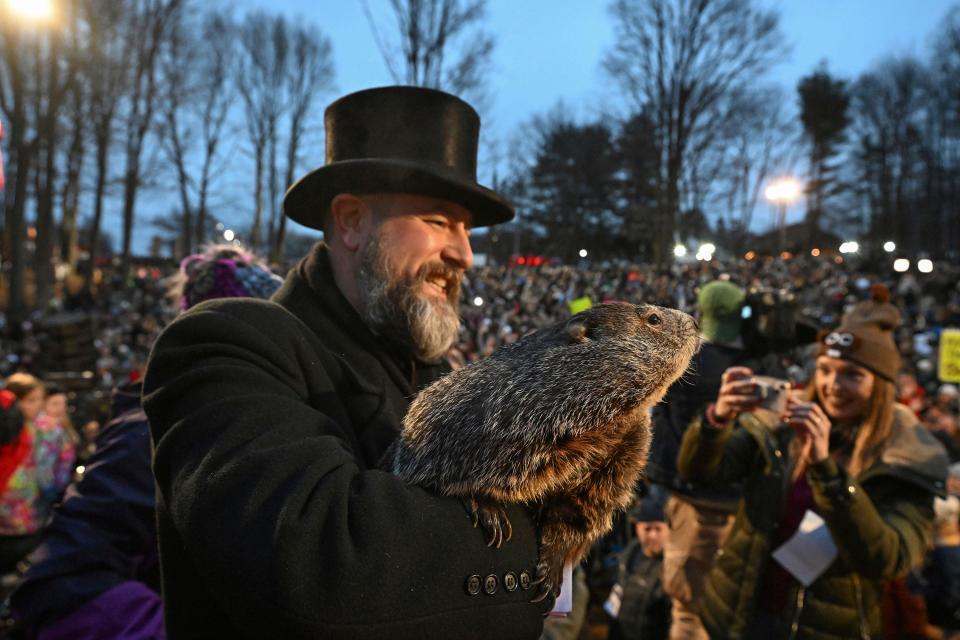Groundhog Day prediction for early spring looks good for now in Delaware. Will it last?
Punxsutawney Phil’s Groundhog Day prediction for an early spring is looking pretty good right now, at least for Delaware and the surrounding area — but that’s going to change.
“Don’t put your snow shovels away yet,” said Tom Kines, AccuWeather senior meteorologist.
But first, the good news.
The AccuWeather forecast for the high temperature in Wilmington is:
52 degrees Feb. 8
56 degrees Feb. 9
59 degrees Feb. 10
55 degrees Feb. 11
50 degrees Feb. 12
“It’s kind of odd. The warm air isn’t just going to come up from south but also from the northwest,” Kines said. “Up in northwest Canada, it’s been amazingly warm – record warmth.”
Cities like Minneapolis and Denver are already experiencing the warmer weather we’re going to see in Wilmington this weekend. The high in Minneapolis was 57 degrees Feb. 6, and the forecast for Feb. 7 was for a high of 55.
Denver had a stretch of springlike weather before Groundhog Day with an average high of 61 degrees from Jan. 28 to Feb. 1.

“I have to caution people – even though temperatures this weekend will be pretty awesome, we do think there’s an opportunity for more snow for Wilmington at the end of February and early March,” Kines said. “If I was Phil, next week, I would hide.”
In Wilmington, the forecast for the high temperature dips to 43 degrees Feb. 13, 42 degrees Feb. 14 and then frigid weather settles in with most days only in the 30s through the end of the month.
Goodbye, early spring.
“There’s going to be a change in the jet stream,” Kines said. “Next week, it’s going to start to push southward.”
That means Wilmington will be above the jet stream. In general, areas above the jet stream are in colder air, and areas below the jet stream are in warmer air.

Origins of Groundhog Day and why it's celebrated
So what’s the history behind Punxsutawney Phil’s predictions?
The National Weather Service reports that traditions similar to Groundhog Day date back to about the 5th century:
“European Celts believed that animals had certain supernatural powers on special days that were halfway between the winter solstice and spring equinox. Folklore from Germany and France indicated that when marmots and bears came out of their winter dens too early, they were frightened by their shadow and retreated back inside for four to six weeks. This was adopted by the Romans as Hedgehog Day. When Christianity came into being, the formerly pagan observance also came to be called Candlemas.”
In western countries in the Northern Hemisphere, the official first day of spring is a little more than six weeks after Groundhog Day, on March 20 or 21.
“About 1,000 years ago, before the adoption of the Gregorian calendar when the date of the equinox drifted in the Julian calendar, the spring equinox fell on March 16 instead. This was exactly six weeks after Feb. 2,” the National Weather Service reported.
When German settlers arrived in the United States, they brought their traditions and folklore. Not seeing hedgehogs in America, the settlers chose a similar hibernating animal.
In the United States, the first known reference to Groundhog Day is from Feb. 4, 1841 in the diary of Morgantown, Pennsylvania, storekeeper James Morris who wrote:
“Last Tuesday, the 2nd, was Candlemas day, the day on which, according to the Germans, the Groundhog peeps out of his winter quarters and if he sees his shadow he pops back for another six weeks nap, but if the day be cloudy he remains out, as the weather is to be moderate.”
The tradition was formalized as Groundhog Day in 1886 by Clymer H. Freas, the editor of the Punxsutawney Spirit Newspaper, who proclaimed Punxsutawney Phil as the official weather forecasting groundhog, but there’s no record of whether Phil saw his shadow that year.
According to the Punxsutawney Groundhog Club, the first official trek to Gobbler's Knob happened in 1887 when Phil saw his shadow with the same result the next year. There are no records of Phil’s prediction in 1889, 1891 to 1897 or in 1899. Another year was missed in 1943 during World War II. Since then, Phil’s prediction has been recorded every year.
Groundhog Day 2024 prediction: See if Punxsutawney Phil says more winter or early spring
How accurate is Punxsutawney Phil? Better in Wilmington than nationwide
The Stormfax Almanac reports Phil has been right 39% of the time going back to his first recorded prediction in 1887, and he’s on a bit of a losing streak.
In the last 10 years, National Weather Service officials said Phil's only been correct three times, but they were very understanding on their website: “Predicting the arrival of springtime for an entire country – especially one with varied regional climates like the United States – isn’t easy.”
More: Don't forget about this famous Delaware groundhog: Chunk
To determine how accurate Phil is, the National Weather Service compared U.S. temperatures each February and March, marking if they were above or below average, then looked at whether Phil called for an early spring or six more weeks of winter.
For the nation as a whole during the past 10 years, Phil’s prediction was correct these years:
in 2014 when he saw his shadow, predicting of six more weeks of winter, and temperatures were below average in February and March,
in 2016 and 2020 when he didn’t see his shadow, predicting an early spring, and temperatures were above normal in February and March,
The other seven years — not so good.
But what about Phil’s accuracy for the Wilmington area over the past 10 years?
He fared a little better than the nation as a whole with four correct prognostications, based on Wilmington’s average temperatures in February and March:
2014 – Phil predicted more winter, and he was correct, with February and March temperatures averaging 4.5 degrees below normal in Wilmington, according to AccuWeather.
2015 – He predicted more winter and was correct, with February and March temperatures averaging 7.9 degrees below normal.
2016 – He predicted early spring and was correct, with February and March temperatures 3.2 degrees above normal.
2017 – He predicted more winter but was wrong, with February and March temperatures 2.7 degrees above normal.
2018 – He predicted more winter and was wrong but not by much, with February and March temperatures averaging 0.5 degrees above normal.
2019 – He predicted early spring and was wrong, but again, not by much, with February and March temperatures averaging 0.5 degrees below normal.
2020 – He predicted early spring and was correct with February and March temperatures averaging 5.3 above normal.
2021 – He predicted more winter but was wrong with February and March temperatures averaging 1.0 degrees above normal.
2022 – He predicted more winter but was wrong with February and March temperatures averaging 3.1 degrees above normal.
2023 – Phil predicted more winter but was wrong with February and March temperatures in Wilmington averaging 3.7 above normal.
With that track record, why do people celebrate Groundhog Day?
“It’s something fun in the middle of the winter doldrums,” Kines said. “The holidays are over and around here, spring is usually several weeks away. This gives people something to talk about and look forward to, especially this year when up to now it’s been rather dreary and rainy with some snow.”
Reach reporter Ben Mace at rmace@gannett.com.
This article originally appeared on Delaware News Journal: Groundhog Day early spring prediction looks good now. Will it last?

